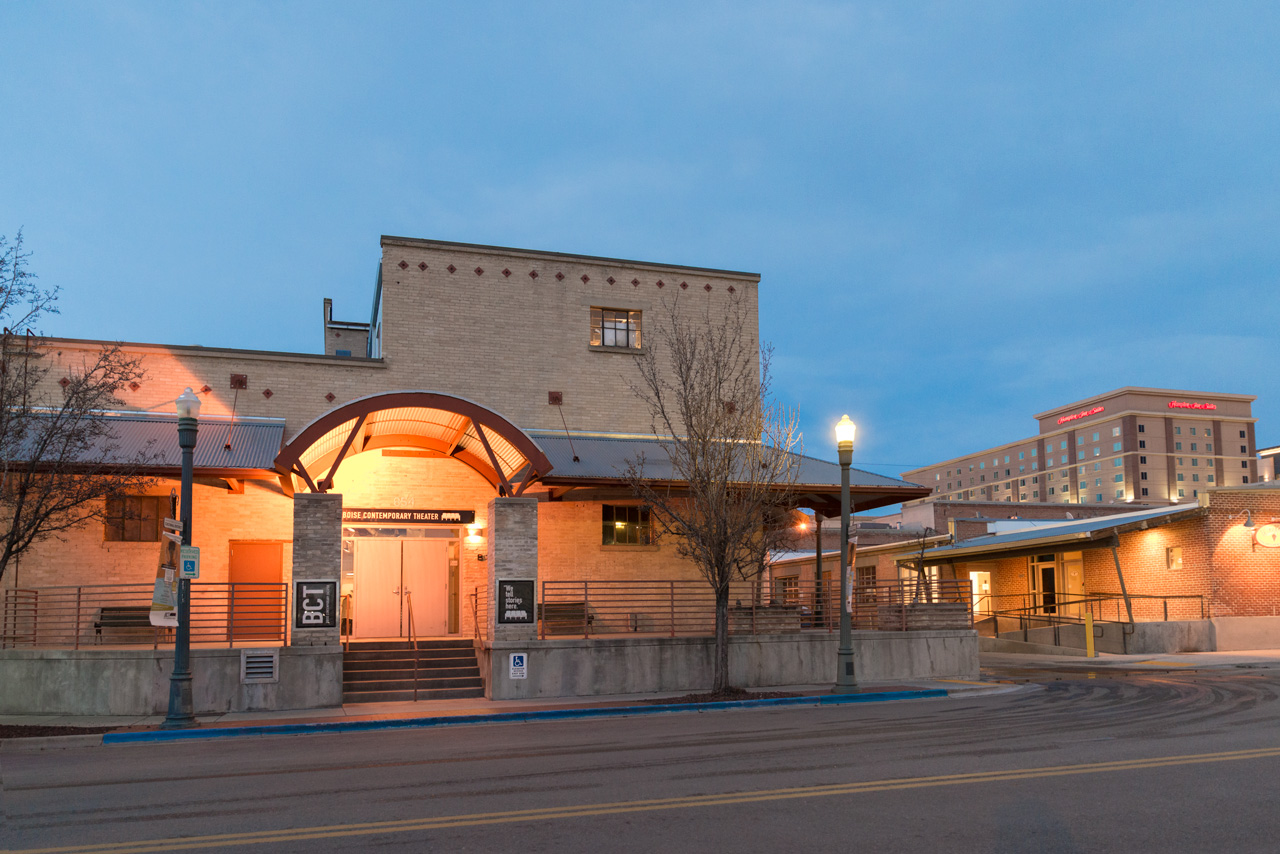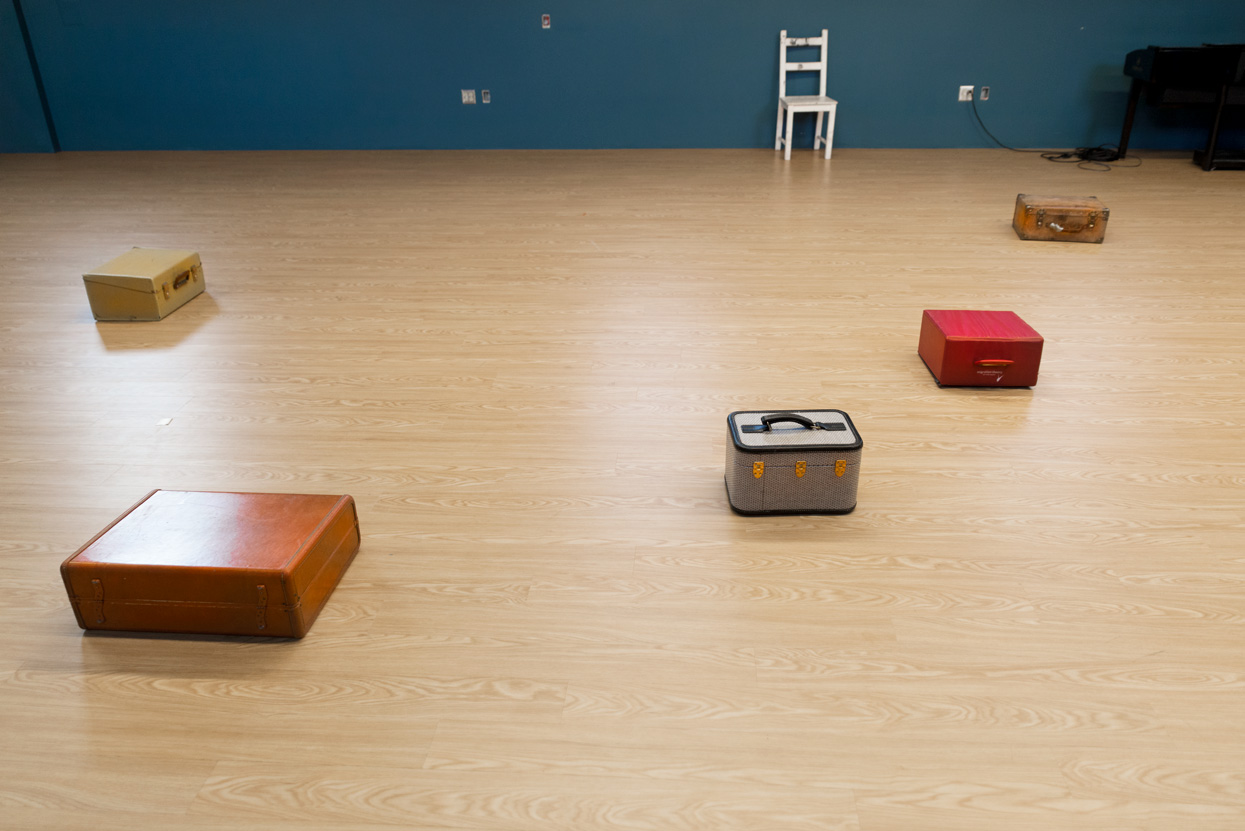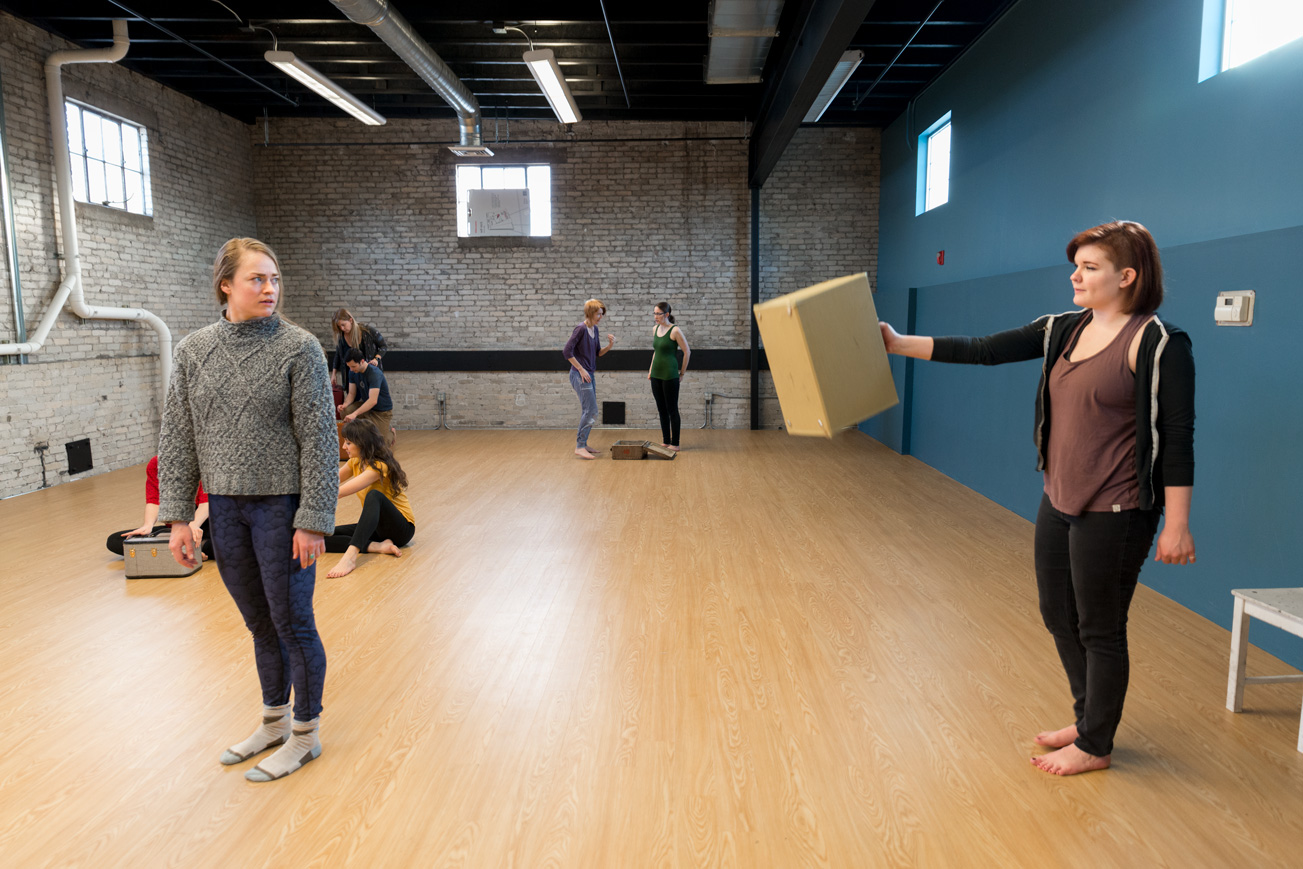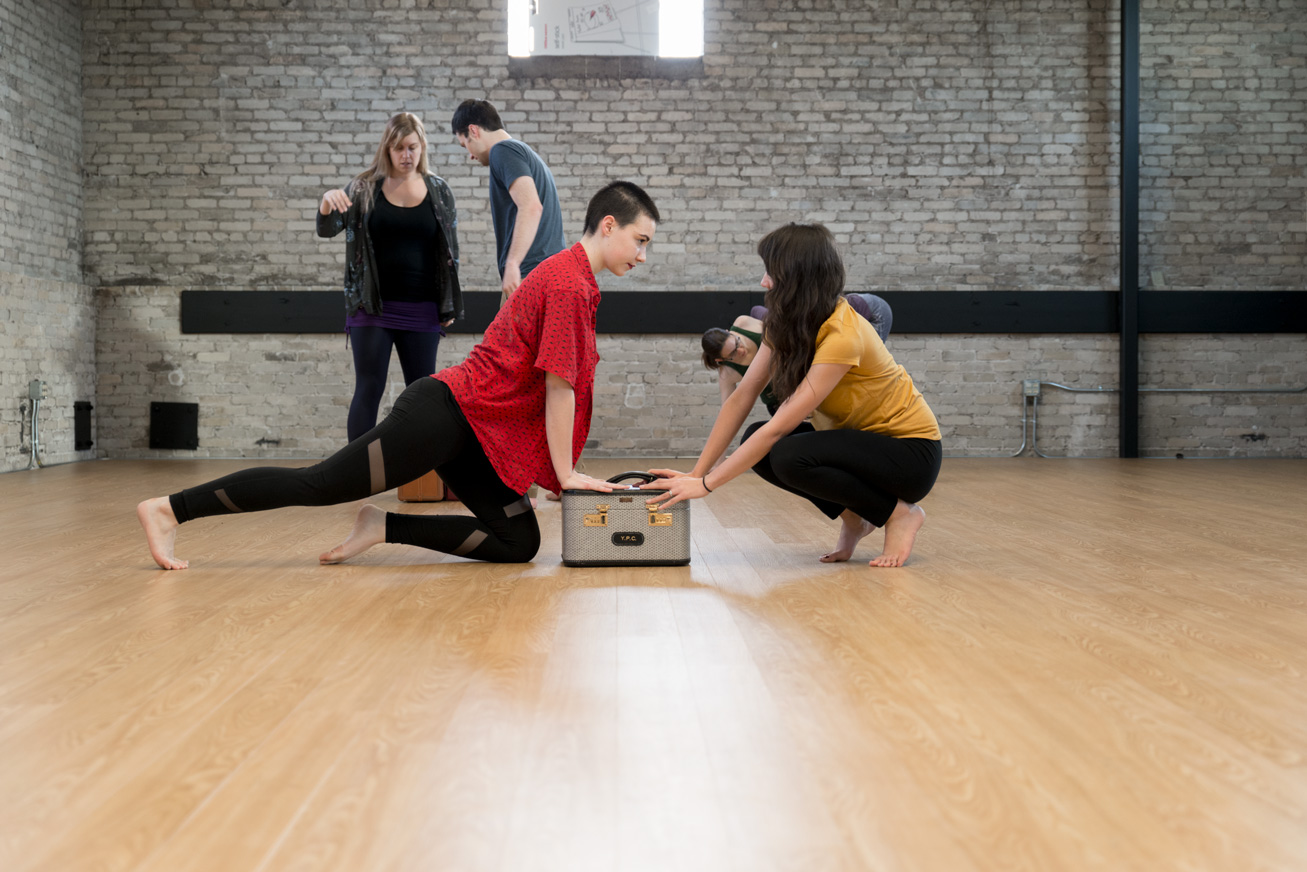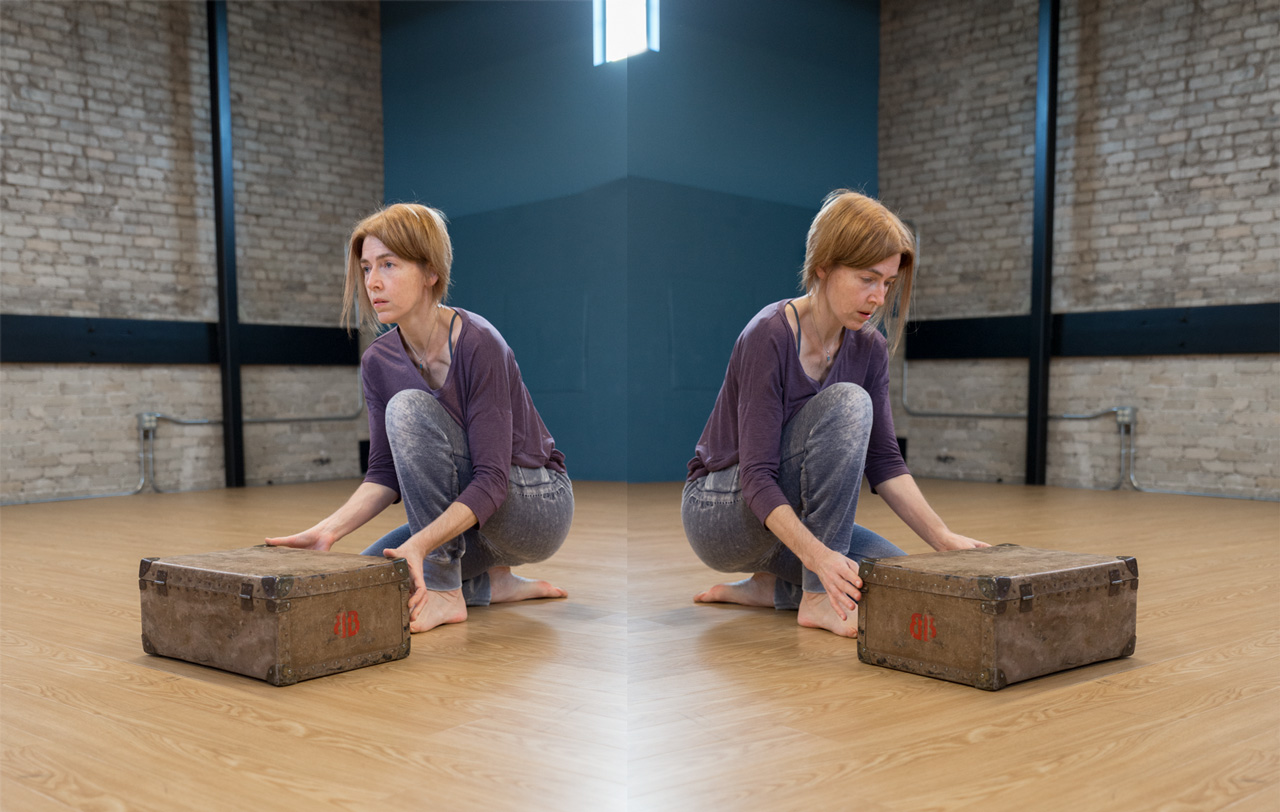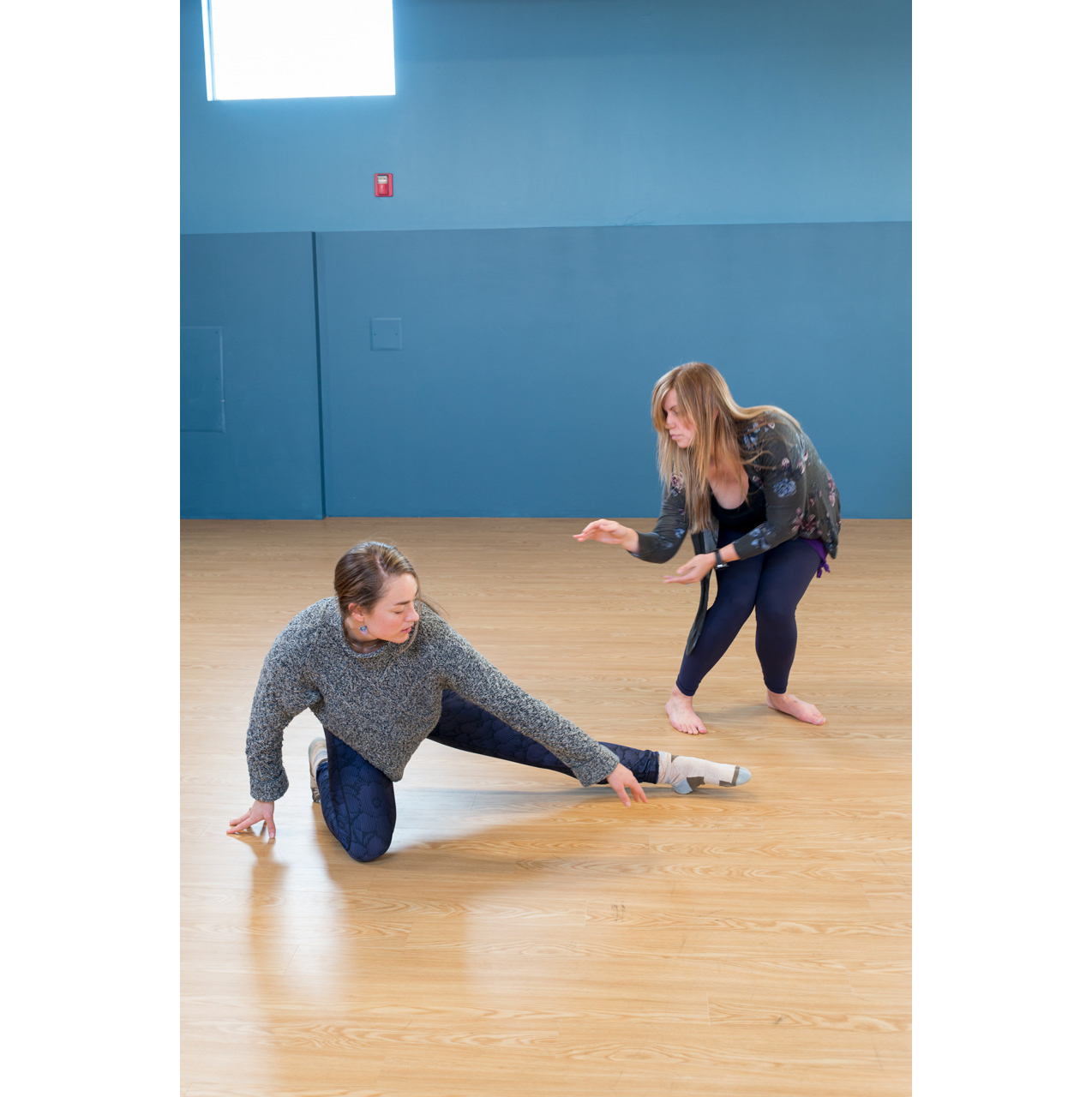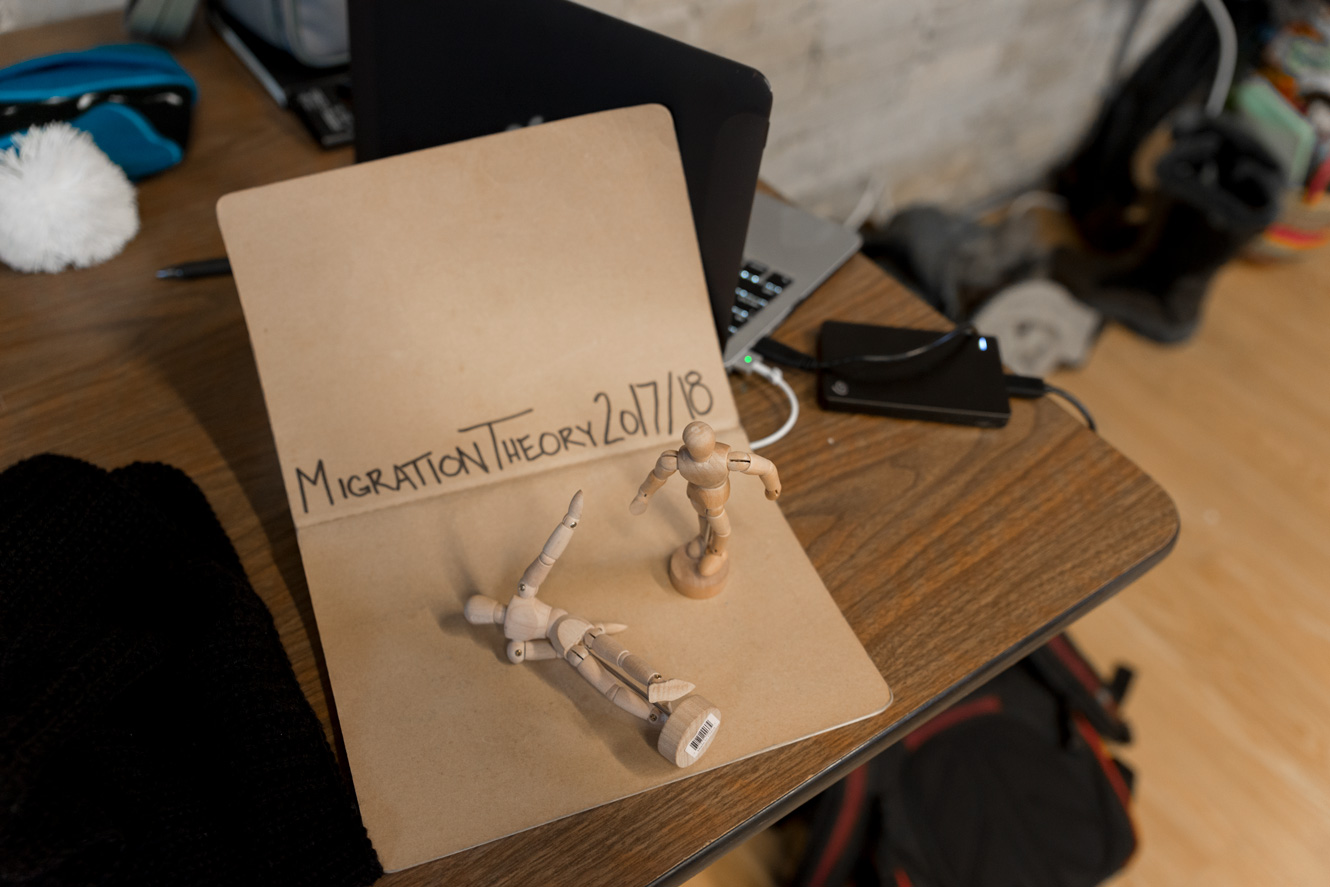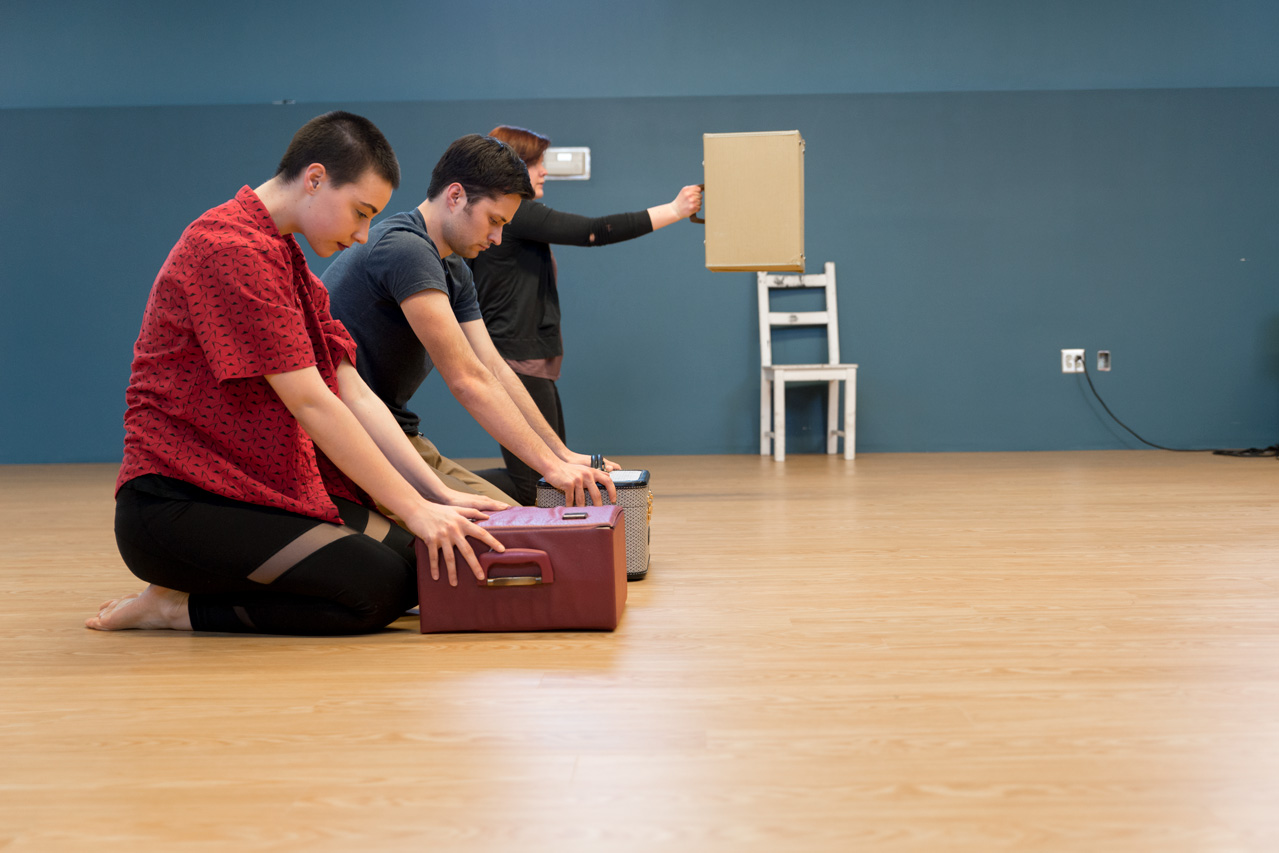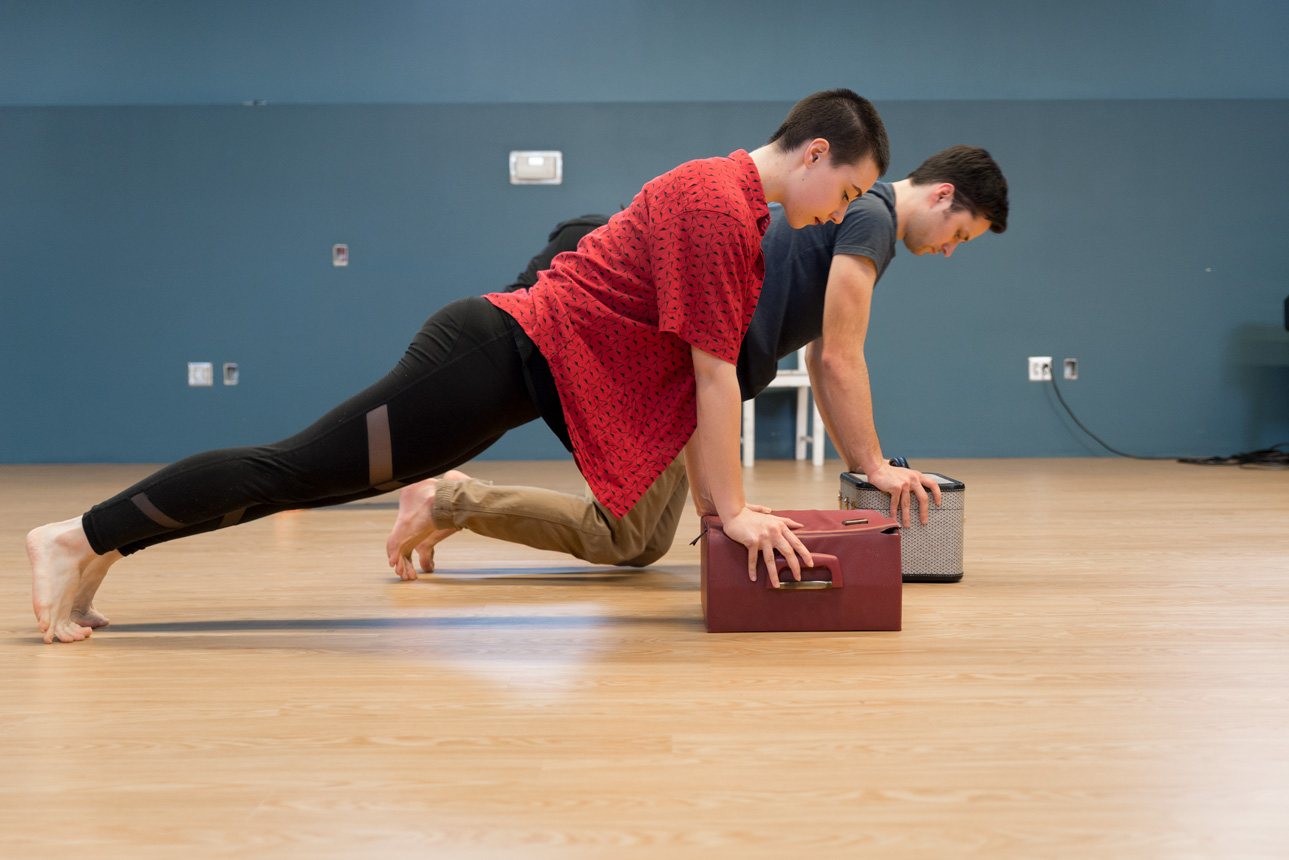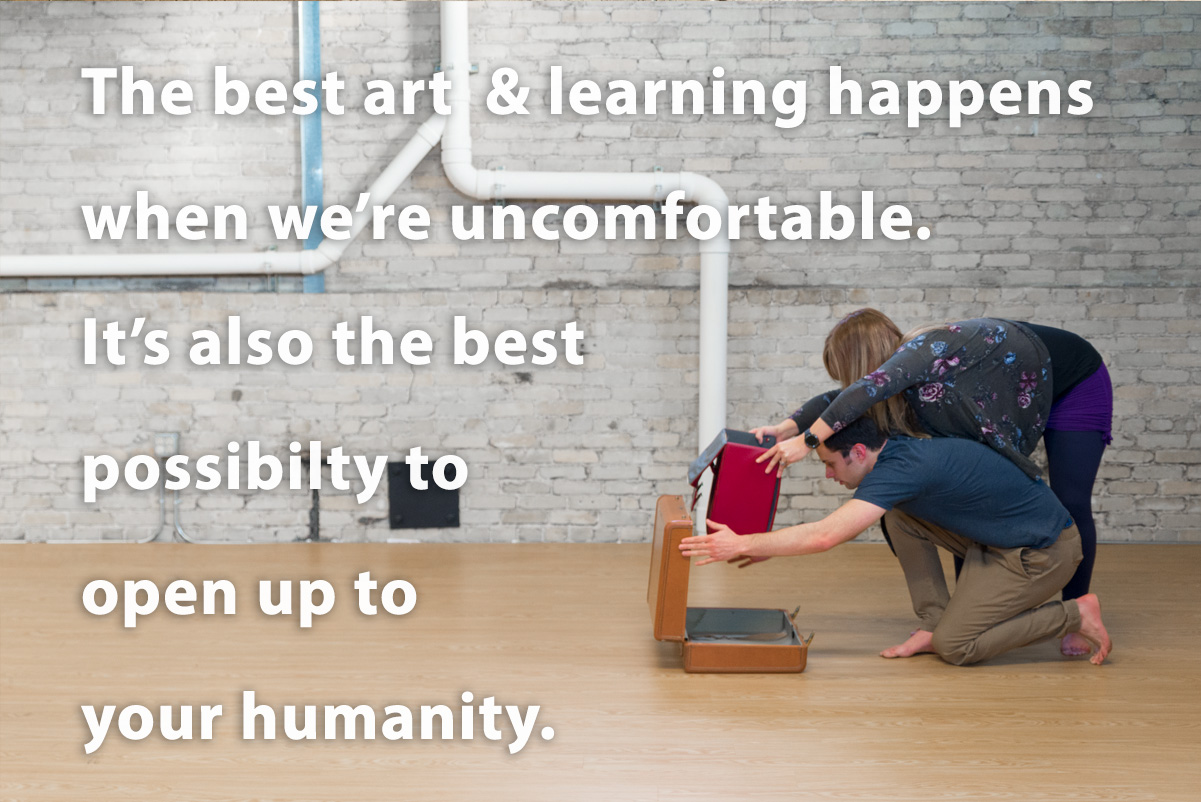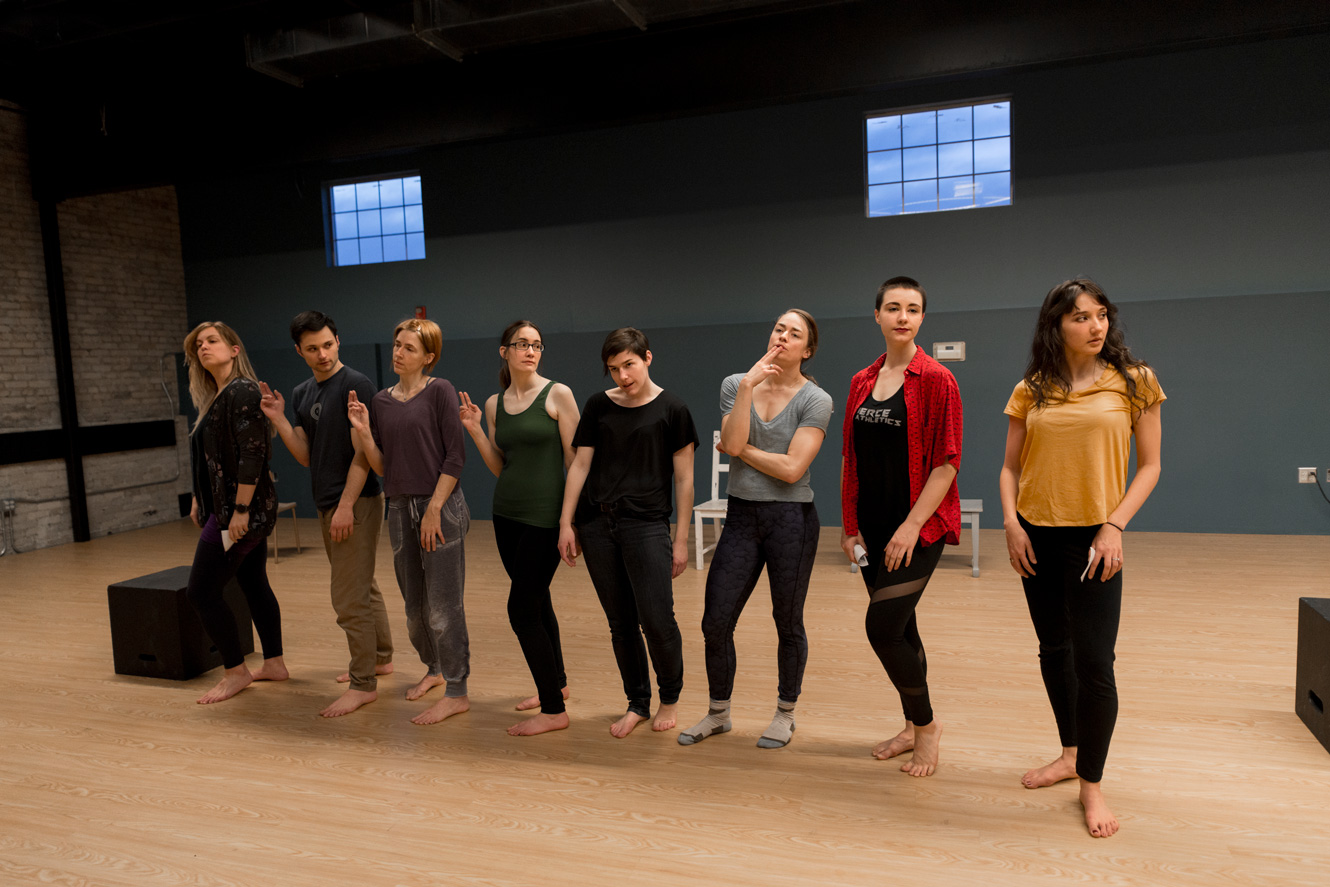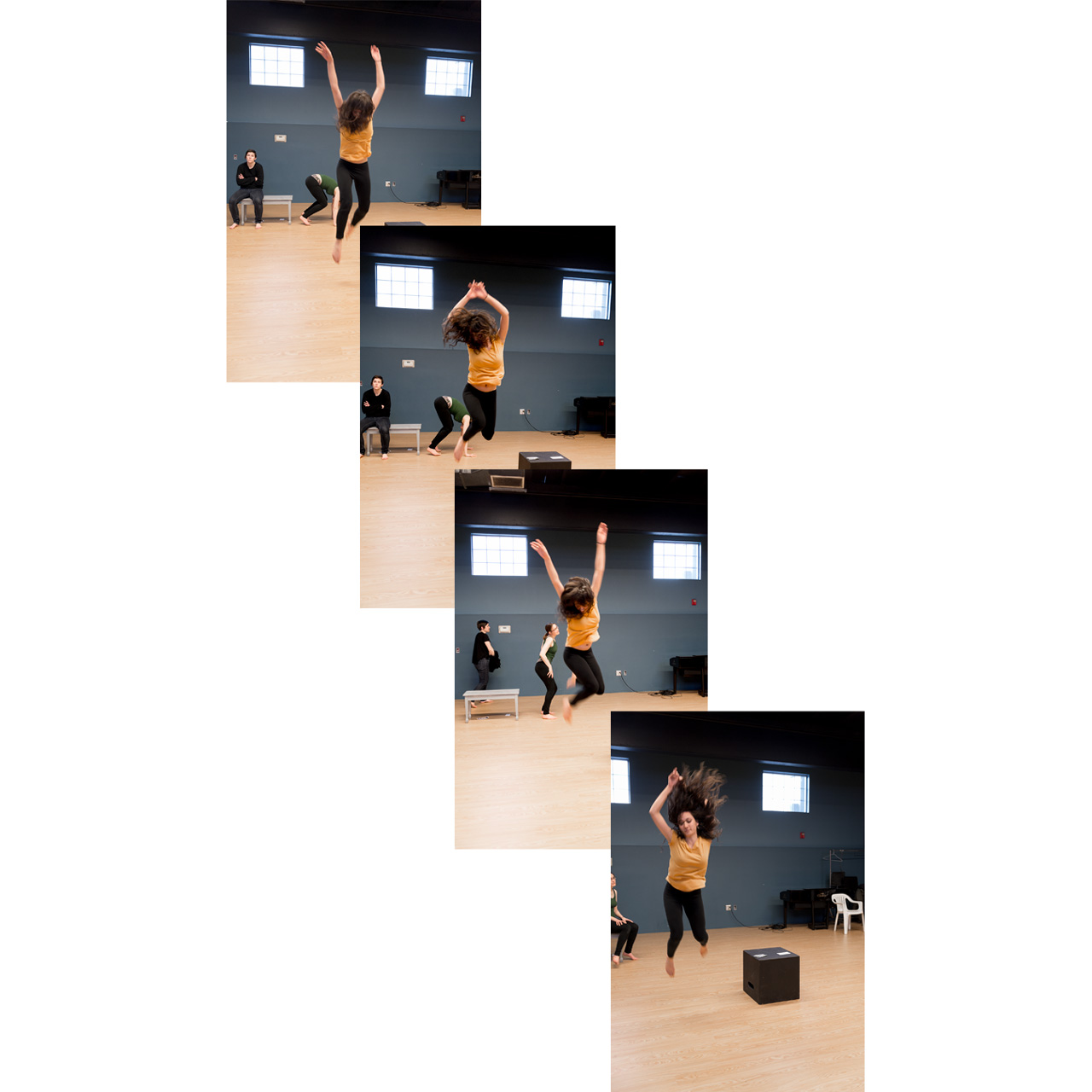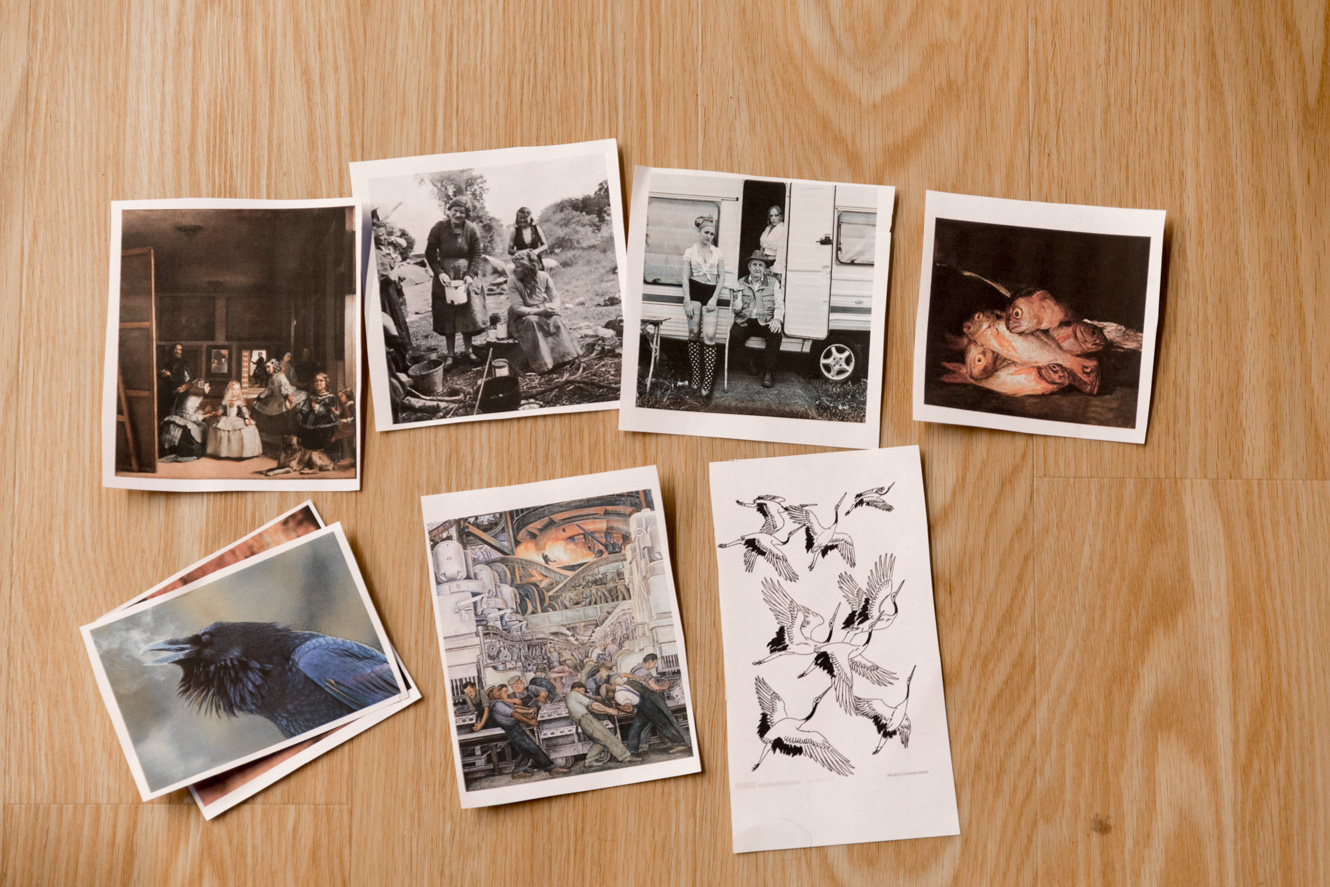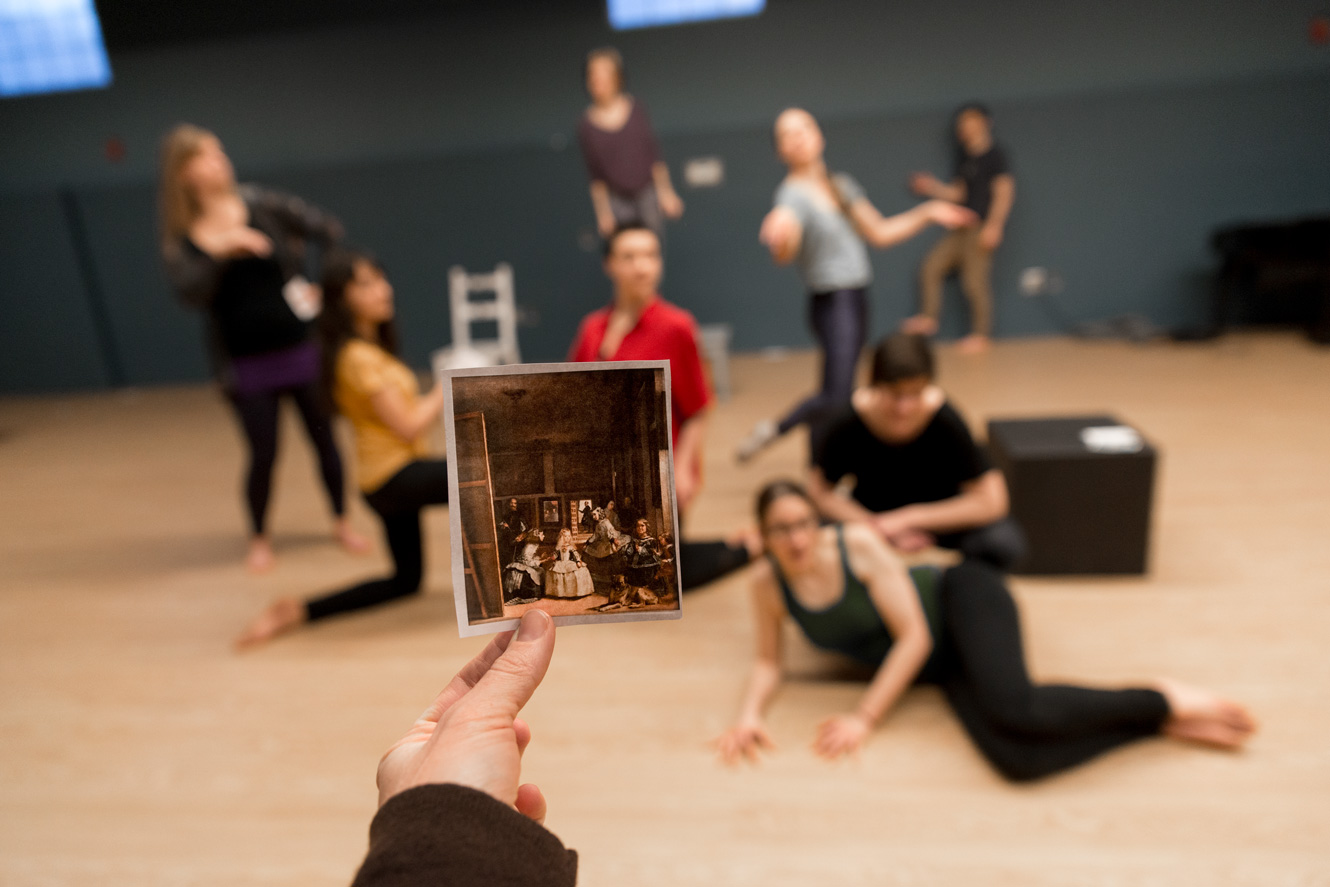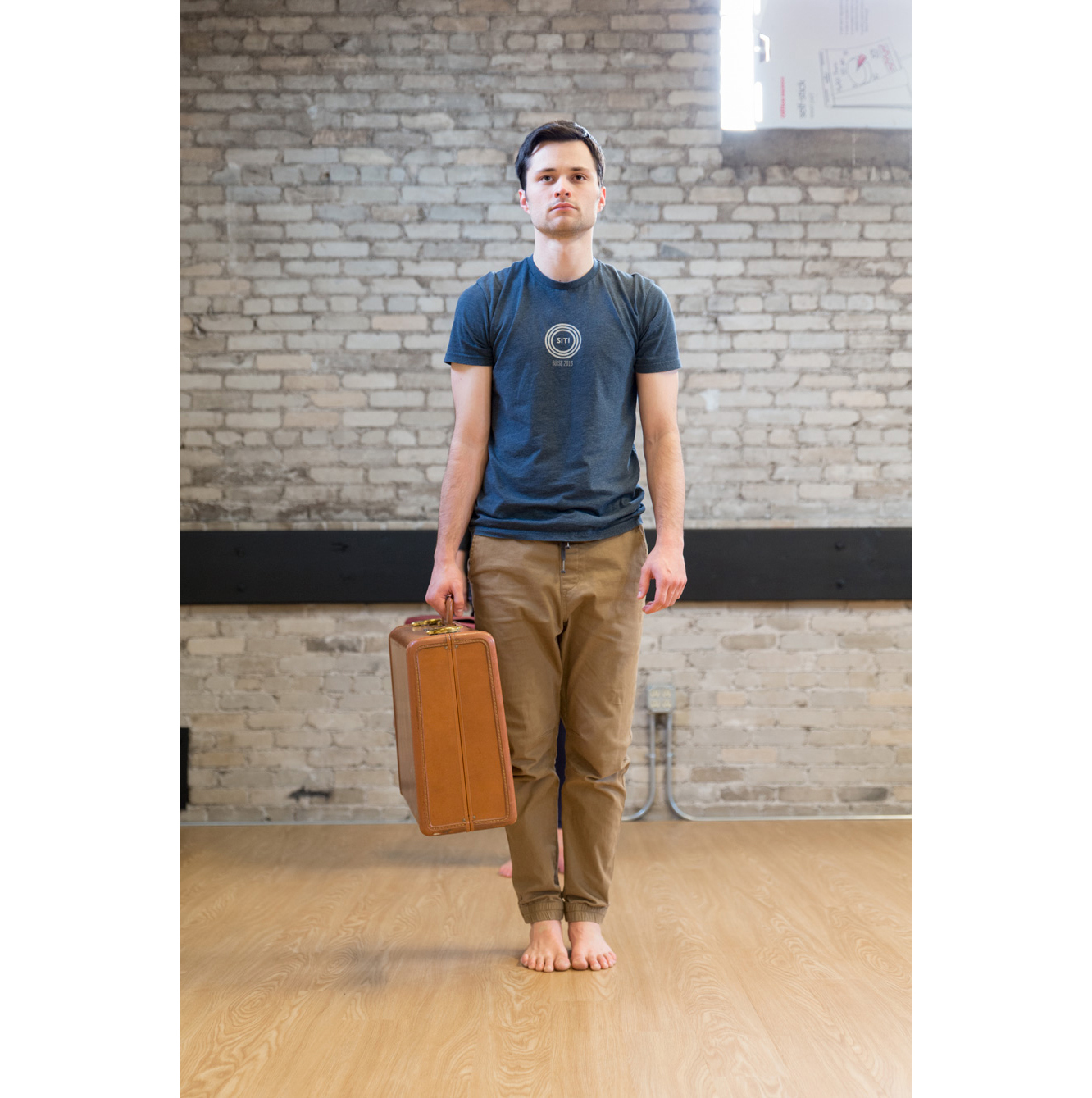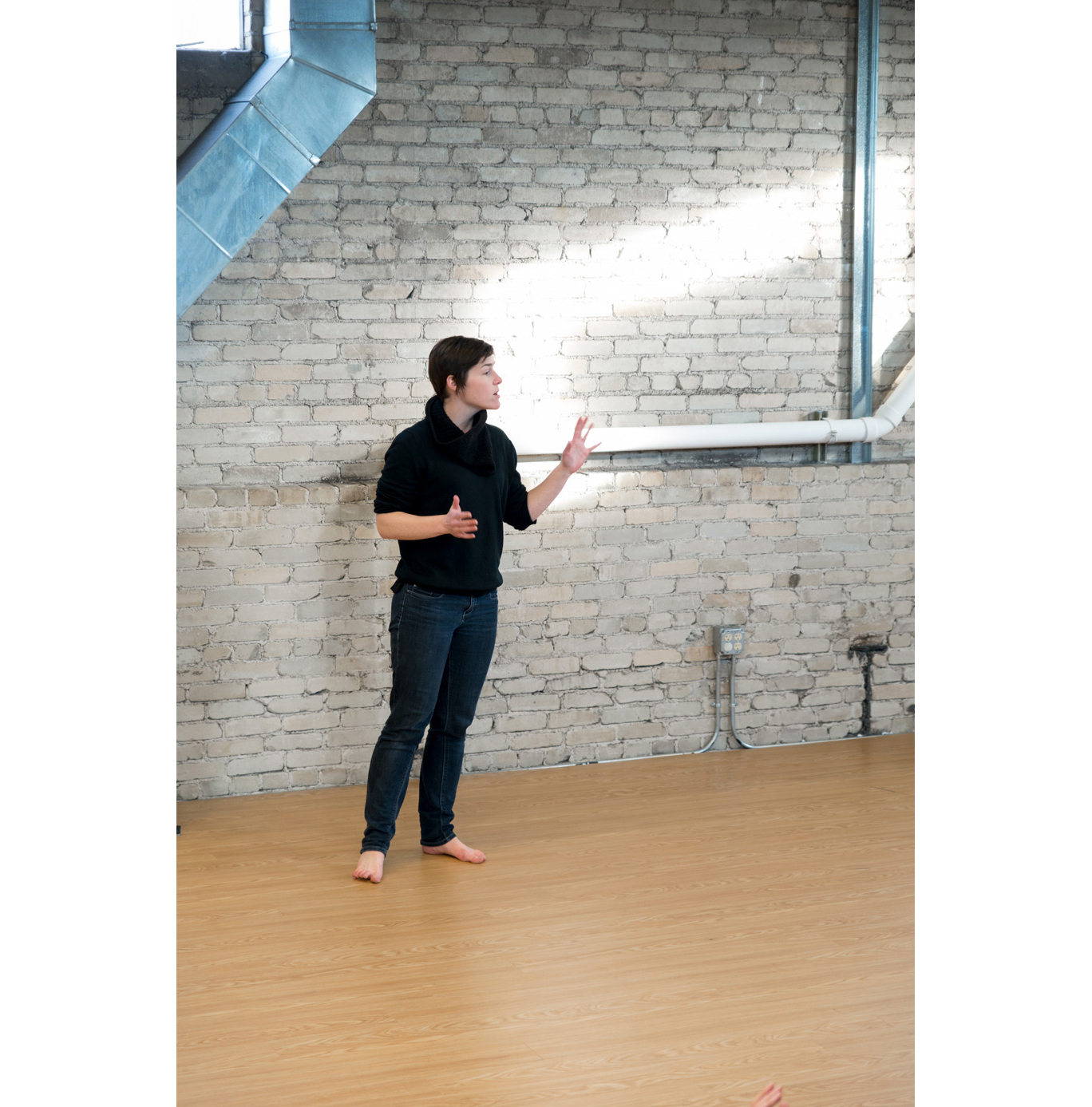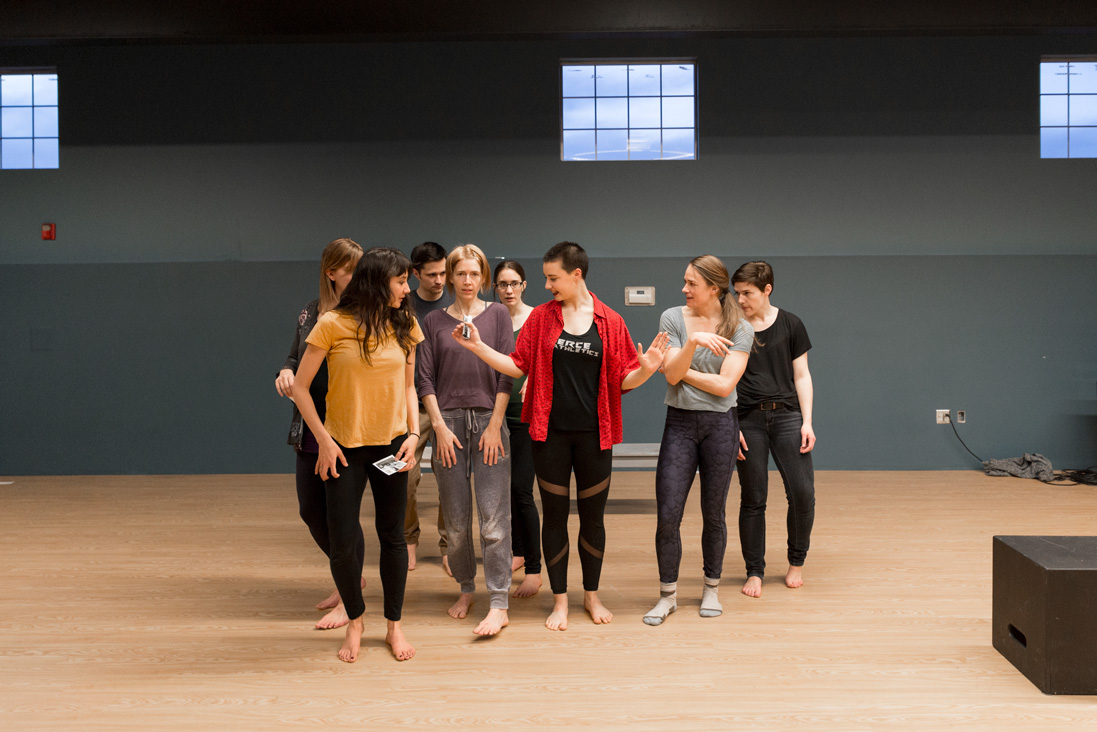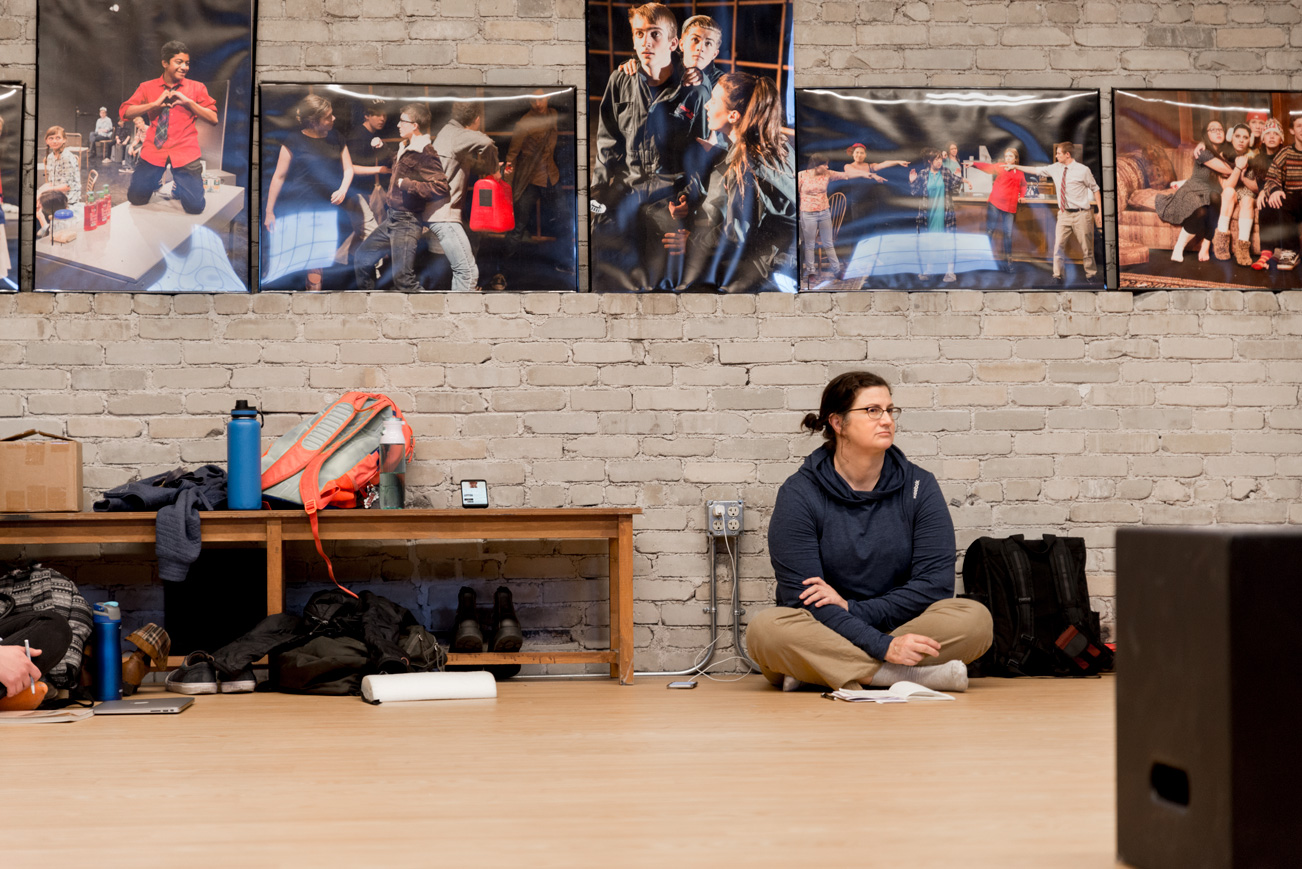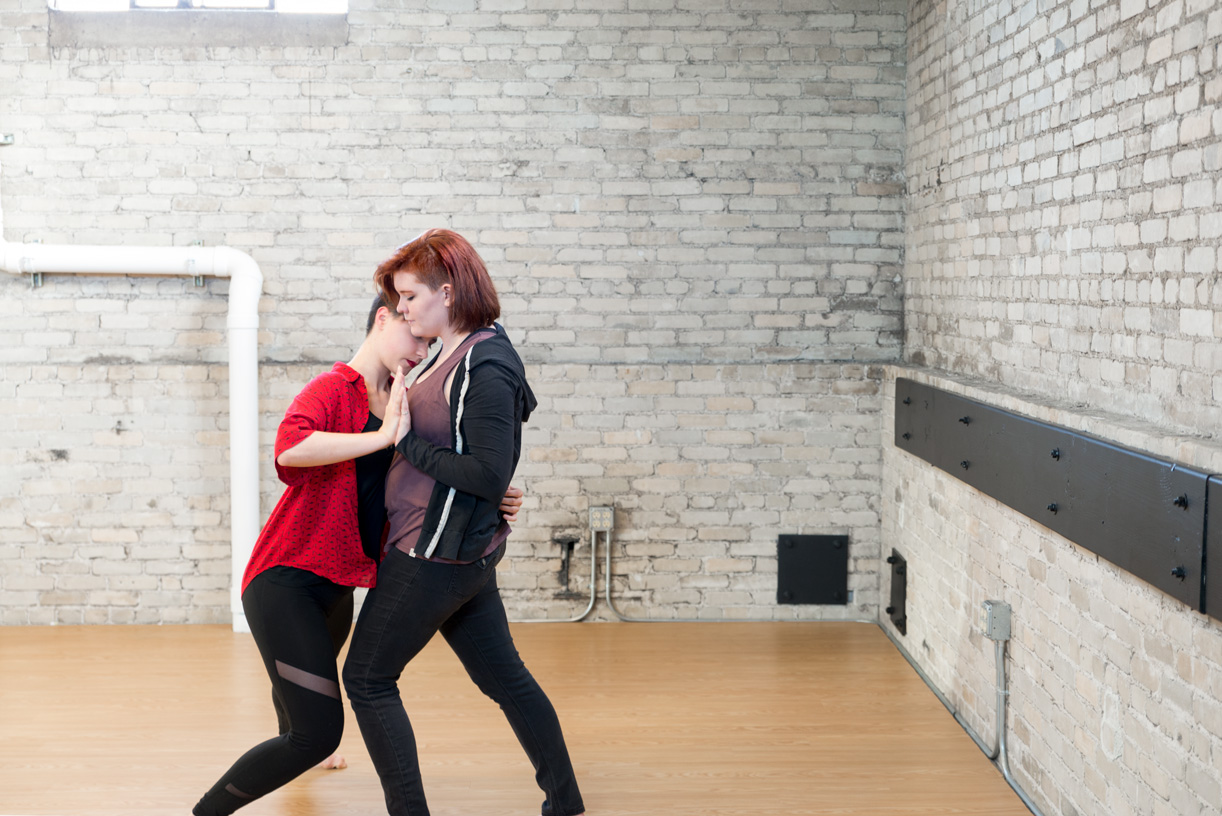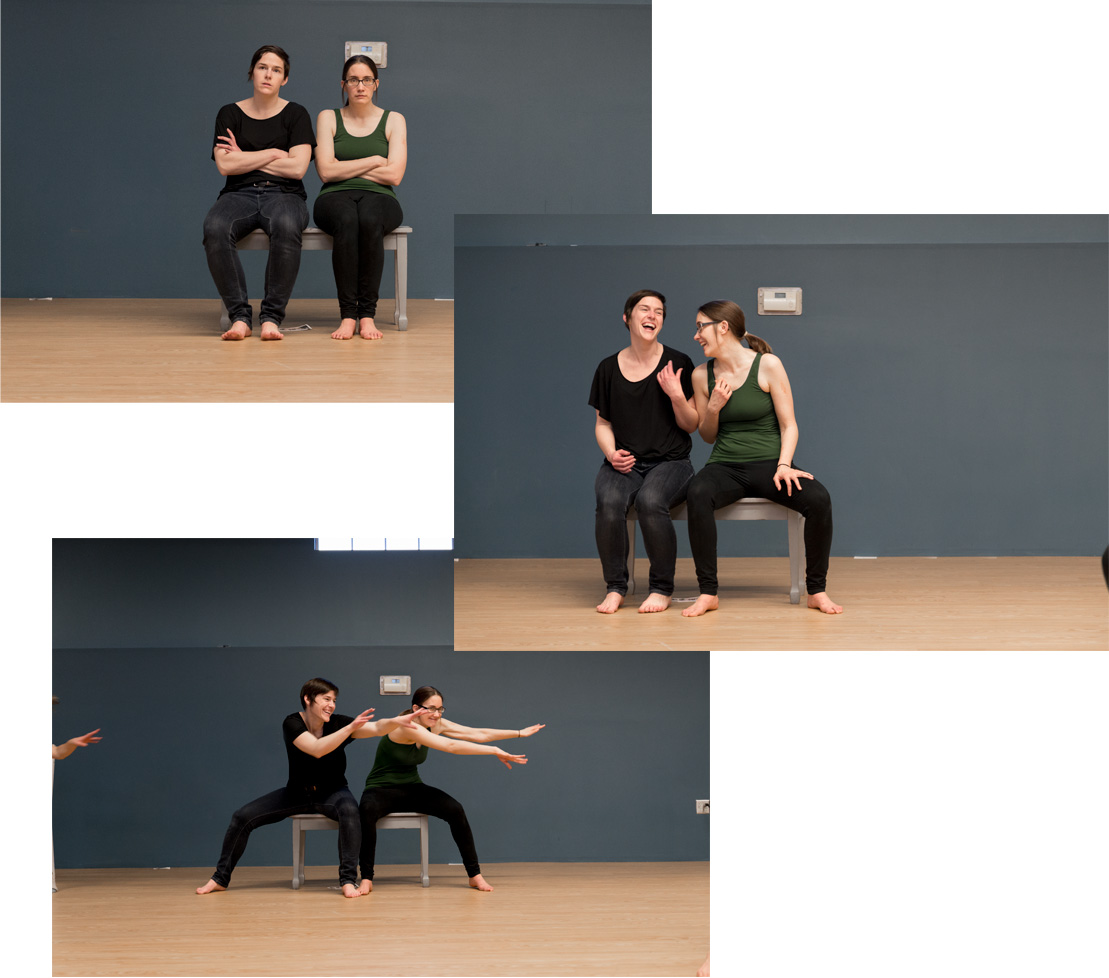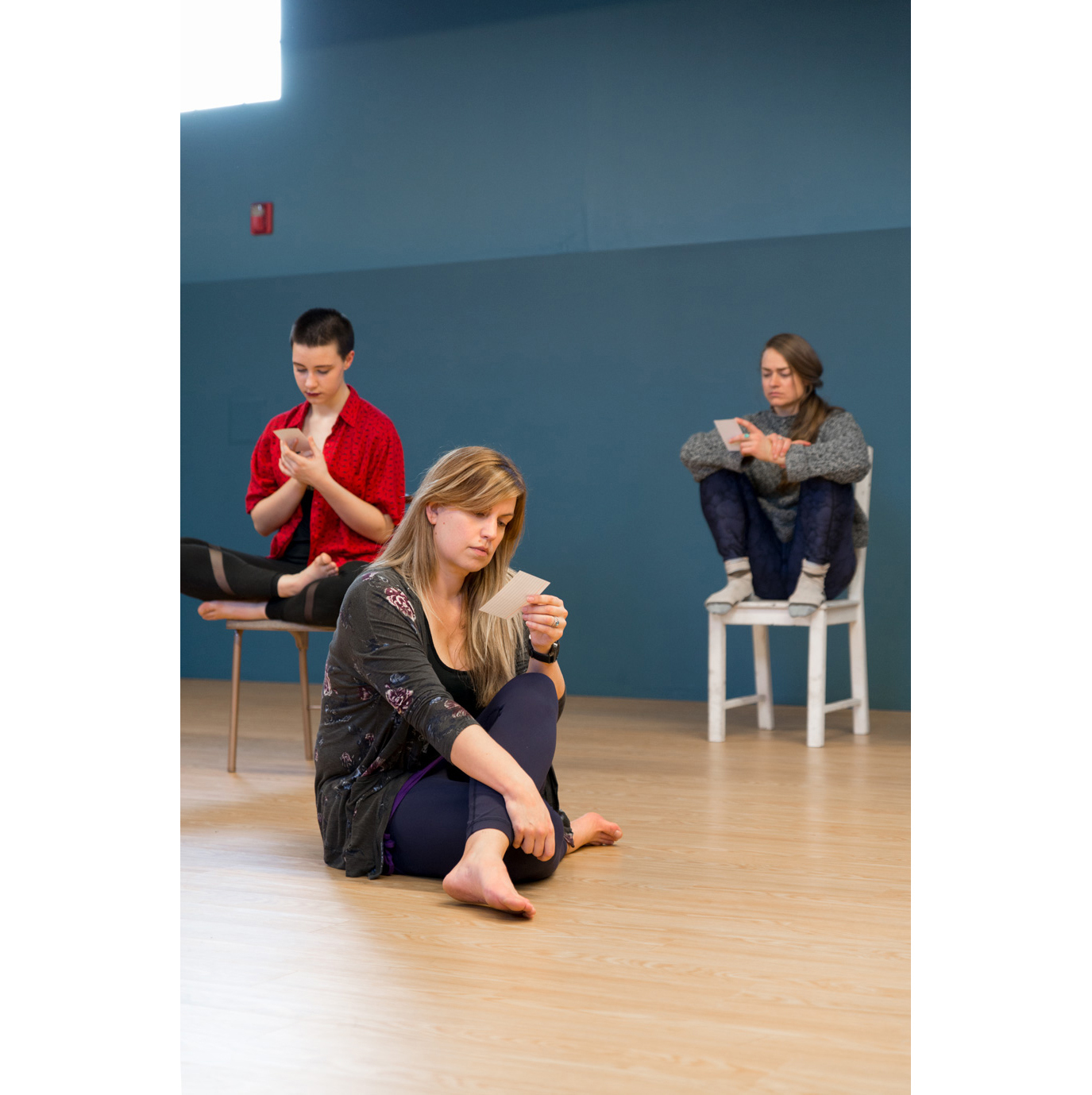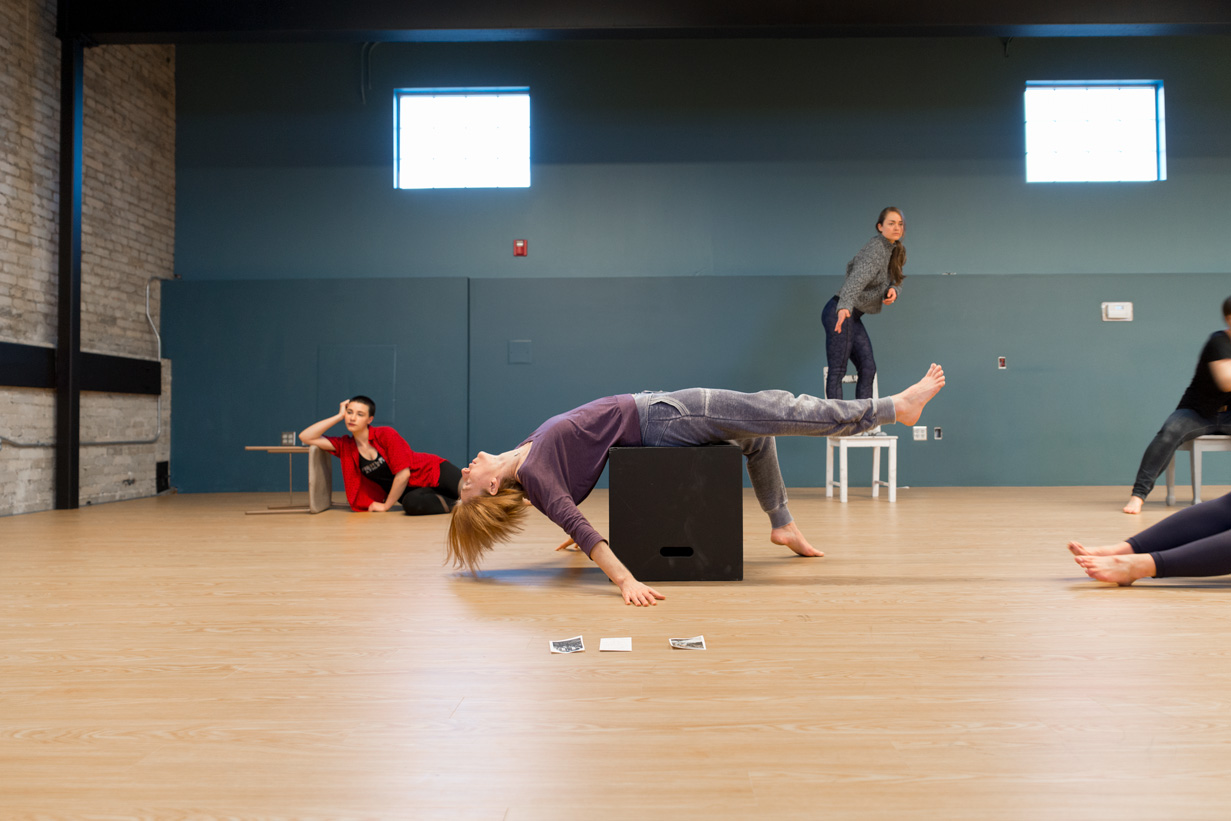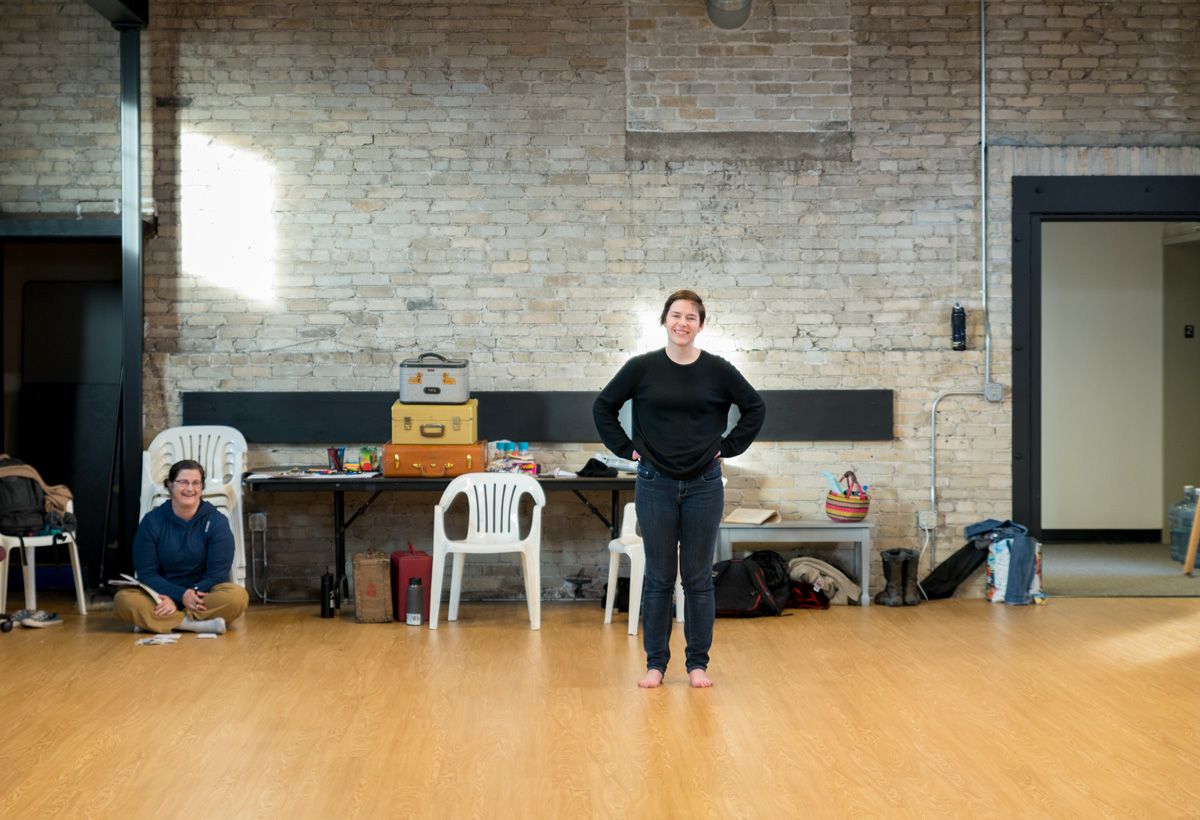Creators, Makers, & Doers: Migration Theory
Posted on 4/18/18 by Brooke Burton
Interview & Photography by Brooke Burton ©Boise City Department of Arts & History
Migration Theory is an ensemble of creative minded people who come together for projects of movement, story, and heart. Their work culminates in a performance crafted for a small audience where they take you out of the theater and into community spaces, complete with natural lighting, traffic, and dog walkers strolling by. They are writers, actors, musicians, and dancers who collaborate for weeks at Boise Contemporary Theater, or sometimes in unexpected places: night walks while scouting locations, or field trips to the art museum. A typical rehearsal will find them exploring everything from humanistic themes like searching and longing, to subjects as diverse as fungi and time, or, the universe. Viewpoints, a favorite movement exercise, is known for evoking visceral and spontaneous moments, turning the standard scripted story on its head. Most importantly, Migration Theory is mindful of being fully present: with the self, the other, the world, and you.
Interview with Artistic Director Tracy Sunderland, Associate Artists Heidi Kraay & Sarah Gardner, Guest Collaborator Lisa Lechner, and Lead Collaborator Cameron Needham.
I thought we could talk about storytelling. Tracy, you mentioned growing up, your family didn’t tell stories?
TS: I think I noticed that when I left home. You really don’t examine your own family until you see other family cultures. And I was, like, “Oh, wow, this is how other families work,” or just developing a wider lens about the way families are and the way different cultures are. My people are from the cold Northeast, where they say little, let alone tell stories. [Laughter] So, “Oh, now I understand more about my people and the history of the ‘shut it down’ [attitude.]” My family culture [didn’t] sit around and say “Remember when . . .” I would find a photograph and my mother would say, “Oh, you don’t want to hear that story.” There was just an immediate dismissal.
Dismissal?
TS: Of stories. As a result, I think—and I’m going to make a sweeping generalization about myself and maybe, let’s say, [a previous] generation of people—We forgot [our stories.] Because we didn’t bring them forward.
Which generation of people?
TS: The vast first migration of northern Europeans. It was a different way of being American—which was: leave everything behind; bury it and don’t talk about it ever again. And [become] something new.
Starting fresh; tabula rasa?
TS: Right. That gets into the culture and you are not in the habit of recreating a cultural narrative because it’s not seen as something of value. Whereas, now our second giant wave of immigration, [laughter] are lovely humans who are hanging on tight to their culture and their heritage and their stories.
It’s a different kind of immigration.
TS: You have an entire generation that says “Wait, we put this all down and we left it,” and another culture that’s saying, “No, we’re going to hang on.” I feel the way we’re related to storytelling says a lot about our cultural wars now. But that’s me as an artist, looking at something poetically as well as physically.
Exactly, it’s how you interpret the world and how you will make work going forward. Liz, you said you were allowed to tell the—
LL: The good stories. The fun stories.
The bad stories are the ones whispered behind closed doors?
LL: Right.
On death beds sometimes. Or after.
LL: Definitely.
Heidi you mentioned your family had some unspoken rules about storytelling?
HK: Yes. There are certain stories we heard over and over, but then there was so much swept under, things unspoken, and things we’re not supposed to talk about. But those that are funny and sweet, that we can talk about.
The sour or problematic things become the subtext of our lives. Which is why we like movies, right? I enjoy watching subtext play out on the screen—as long as it isn’t my own. [Laughter] Since I have a roomful of performing artists, I have to ask, what should I go see?
We would recommend the mapping exhibit at Boise Art Museum. And the Jo Hamilton show, too. It’s interesting what she’s trying to do.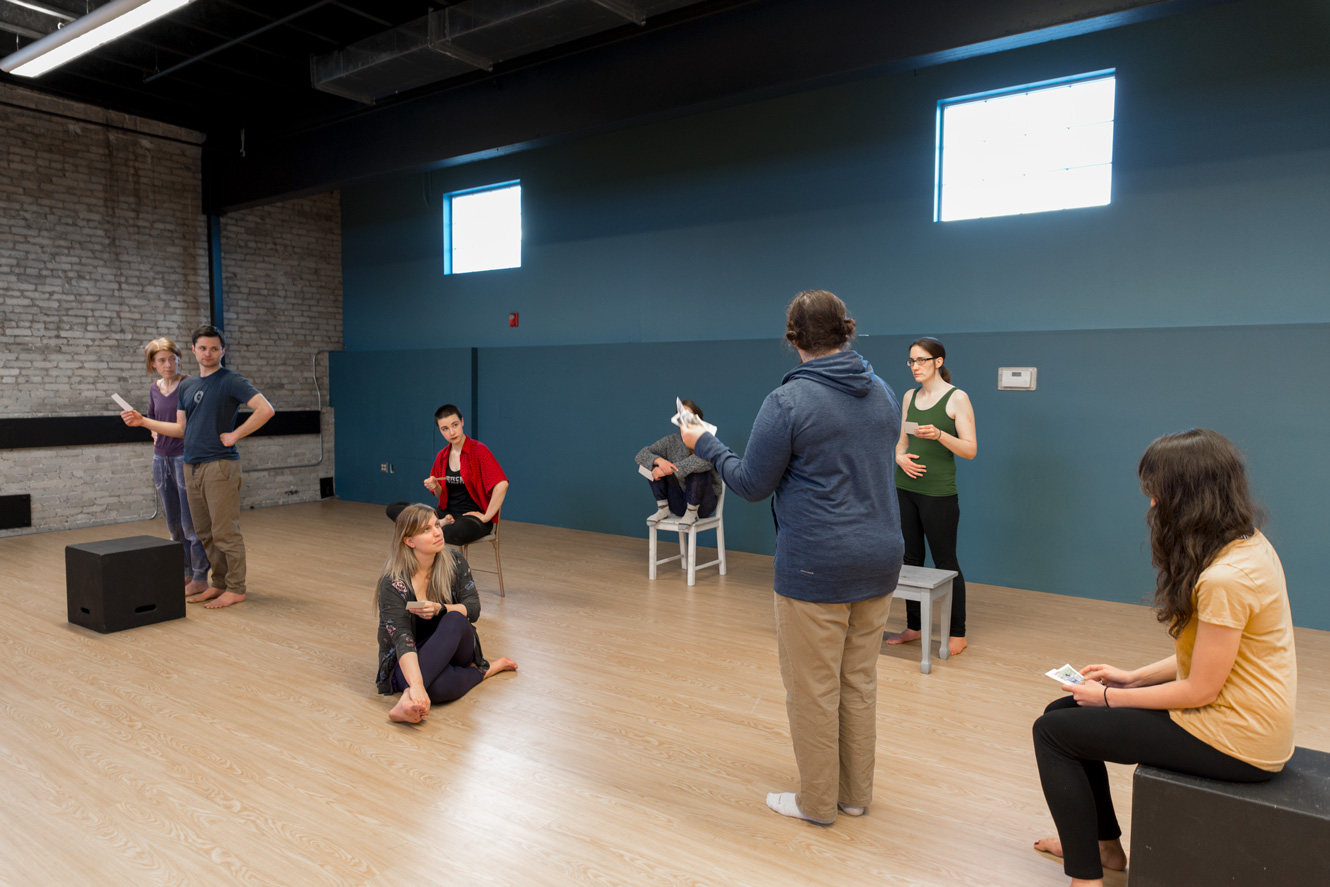 Ok! You surprised me there, I presumed you would tell me about movies or films. [laughter]
Ok! You surprised me there, I presumed you would tell me about movies or films. [laughter]
Part of our collaboration is going to see art together. Usually [an idea or theme] comes up, and we talk about the Baader-Meinhof syndrome, which is, once you see something, it comes into relief. It’s always been there but you’re suddenly seeing it everywhere.
I didn’t know there was a name for that! [Laughter]
My friends and I used to call it the White Subaru issue.
Because if you buy a white Subaru, then suddenly the world seems to be full of them?
Yeah, we’re having just heaps of Baader-Meinhofs right now. We want to explore geography and the ways in which you map: map a life, map a body, map a heart, map a culture—using mapping as a verb, and then we’re like, [pantomimes pulling out a smart phone] “Um, boop, there’s a map exhibit at the Boise Art Museum.”
You’re drawing in all the information that is relevant to your current themes of interest?
Yeah, absolutely. And it feels—
Like it was meant to be?
Portentous, a little bit. Absolutely. And we’re figuring out all the [previous work] that’s already dealt with [these themes] and marinating them with ours. We’re not the first to think about these things.
You’re not re-inventing the wheel? You’re expanding—the wheel?
We’re taking the wheel apart and putting it back together in reverse. And then we’re just taking the wagon and lighting it on fire—We’ll build a bonfire, yeah.
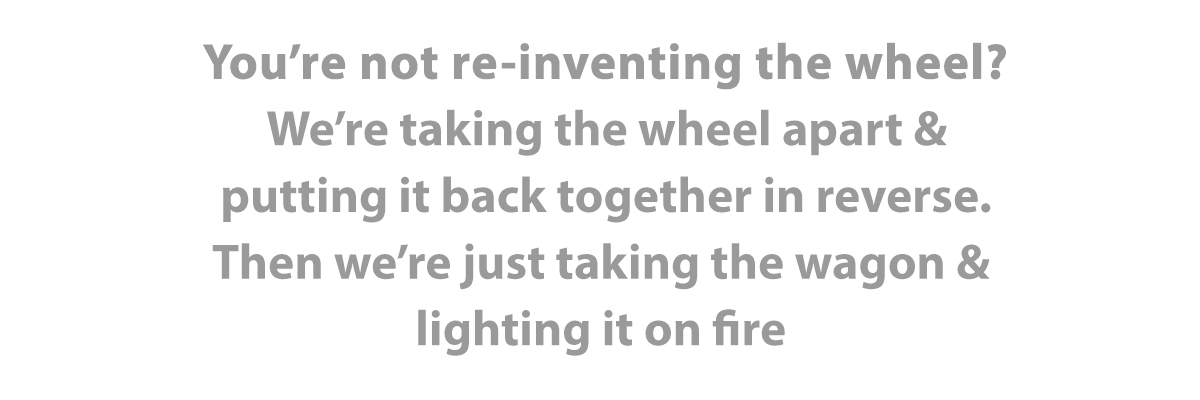
For people like me who have never seen your performances, how would you describe Migration Theory?
The two-sentence summary I’m using, so that I don’t get off on some conceptual pony and ride off, [laughter] it’s basically a physical art company that creates original works that are movement-centric, participatory in some way, and in earnest. There’s always some personal connection—not that it’s autobiographical, but we always mine ourselves, too.
You are looking at larger themes, but also drawing specific inspiration from your own experience? That could be delicate work.
I feel like we get really gritty and vulnerable and open up the whole rib cage, then later look and see which things are universal and which are specific, or shared. It’s as much about the metaphor and conceptual pony [laughter] as it’s about the literal and historical. Our minds and our memories work that way, too. We’re morphing what actually happened and what we think happened.
Who’s to say which is which, right?
I think, probably why it feels so conceptual pony—We coined a term, in this moment, people, “Conceptual Pony.” I think it feels unusual because [our performances] are a constructed, curated way for people to experience stories, ideas, themes, and anecdotes. The personal [becomes] political and the specific [becomes] universal. If we really target what’s happening [in the world,] then hopefully we can reach someone else in a connected way.
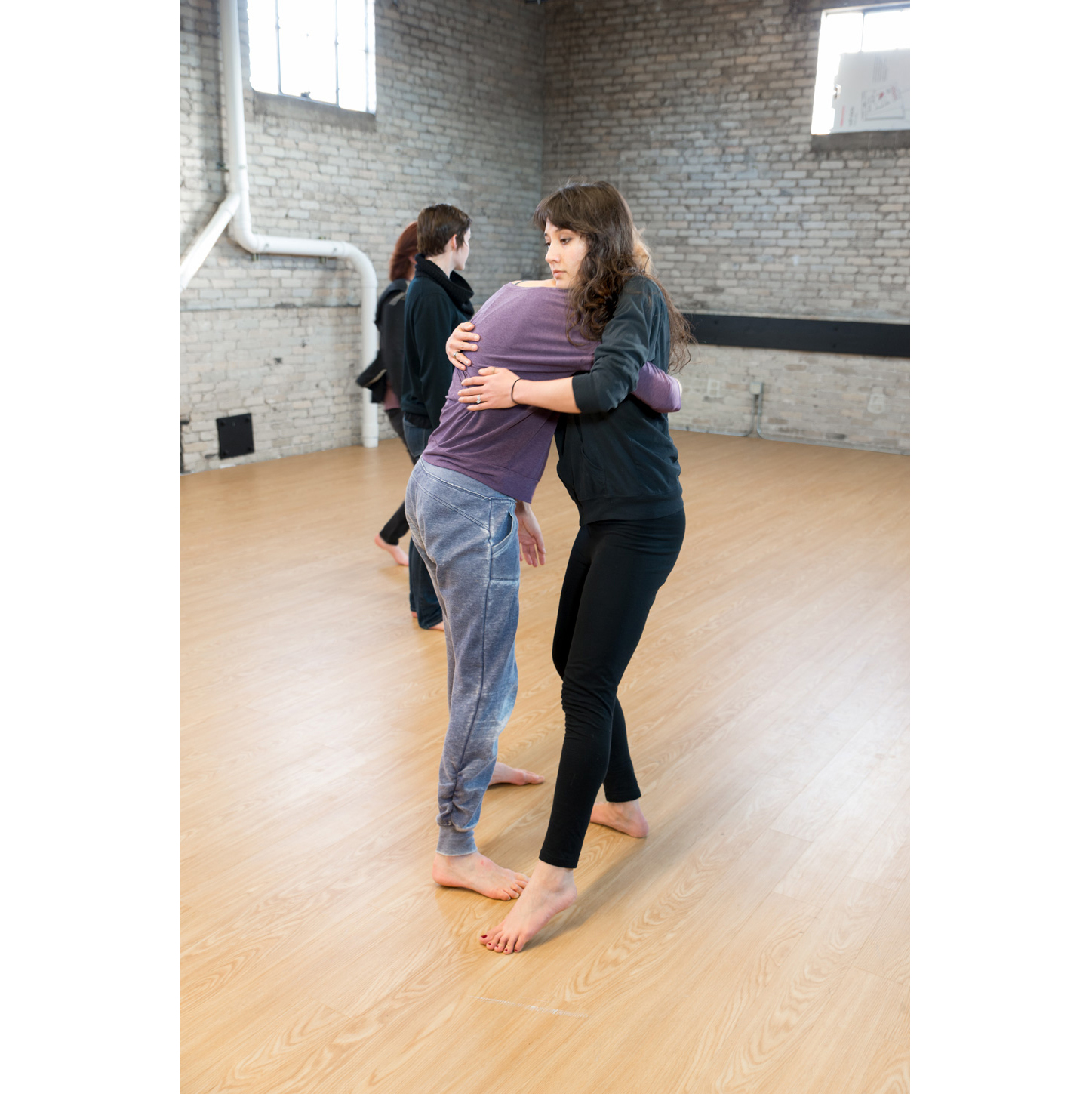 Your themes are current and relevant, then. And this is a performance for a small group?
Your themes are current and relevant, then. And this is a performance for a small group?
Yeah, how cool is it to have an experience that’s been crafted for fifteen people instead of fifteen hundred? We’re really interested in what happens when you make something small. Small Matters.
Small Matters is the title of your upcoming performance. When?
May twenty-second is the first show. Then we run through June sixteenth.
Something else you wrote about is the value of mistake-making and that mistakes—
Are your strength.
Yes, and how as an audience we’d rather watch someone try than succeed. I went to see the ice-skating movie “I, Tonya,” and I feel kind of guilty because I’m not interested in Nancy Kerrigan’s story. I think it’s because I would rather watch Tonya Harding try and fail than watch Nancy Kerrigan succeed.
That’s actually a Pixar rule of storytelling, so I can’t claim it. Pixar’s “22 Rules of Storytelling” from Emma Coates. It’s very good. We as humans want to watch people try; if it’s just a stream of successes, then who cares? [Laughs] The best art happens, and learning happens, when we’re uncomfortable and when we’re failing. It’s also the best possibility, if you’re vulnerable, to open up to your humanity. And we might be able to be a better community because of that.
What does it mean to open up to your humanity?
I think it means empathy and connecting with the hard stuff. Stuff that maybe I don’t want to like about myself, or big shame. When I say, “It’s okay. I’m going to love that [part] too,” then I might be able to love other people who have a shameful part about themselves as well—not that anyone else would have a shameful part about themselves. [Laughter]
Oh, no, no, no. No one else has shame. Of course not. Except that there are hundreds of self-help books dealing with shame.
And now, with Small Matters, we’re deeply exploring the theme “How do we care for the Other and how do we care for Other-ness, as humans?”
What is Otherness? What kinds of Other are you caring for?
All of them. As many as we can. The Other could be something like—broken bodies. Other could be what I’m seeing across the room, it could be poetic, or—you are Other because you’re simply just not me, right?
That’s the most basic interpretation of Other.
It can go into all of the differentiations of minorities as well. We’re looking at race or religion or ability or—so many. I love [the idea of Other as] what is just across the room, because we’re also playing with scale, so Other could be another planet that’s a thousand billion miles away and then it could be a tiny ant that is trying to make its way to its colony. And we decide we want to smash it. [Laughter] It’s also situational. Right now you’re Other because you’re not part of this group or, you know, another [situation] is high school, everybody feels Other in high school.
Oh yes, I remember that.
Aging [and death] is a big Other. Again, the stuff we talk about in whispers. Other is a big, old, beautiful pot for us to just dive in and [stir up] [makes whirring noises], which is kind of where we are right now. There’s a lot marinating for us right now.
Yum.
We use words like “we’re in process,” “we’re developing,” “we work from form as well as content.” But people want to know what the plot is, so I respect that, but there is no plot. [Laughter] It’s not plot-driven. There are narratives.
It’s not plot driven, it’s—
Movement driven. Story driven. Heart driven. Or sometimes we talk: You, Science, Myth. The personal, the scientific, how the brain works or how memory works or how fungi work or—Time. We’re really interested in how time works, talk about the conceptual pony.
I think you’re idea-driven as well.
Yeah. But [the performance] doesn’t feel intellectual at all.
Because you’re churning on all the ideas in process and marinating, then condensing it down into this performance of movement, heart, and—
Story.
Story. But not plot.
The stories that we’re talking about are stories of people in-between.
It’s really hard to label the in-between, it’s kind of like negative space in a picture or a painting. It’s there, but it’s kind of the leftovers, or the the background noise. We tend to think of accomplishments, or times of stability as focal points in our lives. It’s easy to overlook the in-between.
Right, absolutely. The characters might be in-between home: a new home and an old home. They might be between the past and the present. They might be between who they were and who they are now.
Transitions.
Stories of exile, of going to but never arriving, of coming from and the journey home.
Did you say “never arriving”?
Yeah.
Trying to arrive is like, my life story. Why do I do that to myself? Sorry—Why are people so obsessed with arriving? [laughter]
We’re here right now.
Exactly.
It’s challenging. And for the people in our stories, often-times it’s challenging just to move. To take that step forward—or backwards—in order to heal.
Does healing happen in the in-between, I wonder? I am beginning to see why your work is not plot based. I’m finally getting it. And your process; you are truly collaborating, there is no single person shaping the vision, or writing goals, or directing, or whatever.
Yeah, we genuinely create [the performance] in the room together, which is an unusual way of working. We’re pretty unique that way here.
That takes a lot of vulnerability and trust. There is a reason it’s uncommon, I think. You’ve said you want to tell an honest love story in an era of irony. Yeah, what is up with all the irony?
We’re so cynical. I think that’s where the earnest comes from—We were very keen to have that be part of our artistic motto.
Being earnest? Turning away from irony?
Earnest art.
Do you think this is a shift, a cultural shift? Are we ready to turn away from irony finally? I hope so.
TS: I don’t know. I think of my favorite novelists growing up; Evelyn Waugh, Kurt Vonnegut—I think the irony I’m talking about is the incapacity to care about something, or the way that we’re making art now is to make fun of making art.
Using irony as a barrier to engage our emotions?
TS: It’s become a way of making art that I have become tired of. I love irony as a literary device [laughs], as dramatic irony. So, I’m not, “Banish irony.” [Laughter]
No, not as a literary device.
But as my primary art-making tool—
Or as a way of interpreting the world—
It’s a little deadly on our hearts to not engage with the thing that we’re making and the thing that we’re seeing. We’re sincere. We’re so sincere, you know, sometimes I’m like, “We’ve got to tell a joke.” [Laughter] But as a culture, we’re so used to being disengaged. We’re so good at it. We’re so good at putting the walls up. I feel like we need more practice in the Other. So, that’s our Otherness. We are heartfelt. We’re giving our hearts for you. We’re just trying to dig in and do something that is meaningful to us and is meaningful to the audience. And sometimes that requires pushing away, and looking at it from a distance. Not to say there’s no joy and fun and humor.
Yes, you can have all of those things without a mocking overtone. But you aren’t doing it in the usual manner with a script and characters?
Part of our MO is to capsize the theatrical experience and activate it in a fresh way by taking people out of the passive environment of the theater and into the community in which we live. Our tag, “Art that moves,” is meant to be both literal—we’re physically going to move you through stories, and also hit you in your feels.
What can I expect? I know Small Matters will be different from your previous performance, but let’s pretend: here I am, a theater patron. I’ve got my ticket, I’m walking into a dark venue, I am sitting down in my seat and waiting for the curtain.
Nope, you’re not doing that here. We don’t do any of that. [Laughter] You’re not going to sit in a dark room, you’re not going to wait. We’re going to come find you.
Find me?
[Last time] we gave you coordinates, and a little map, to meet us, essentially.
So, I’m still buying a ticket. That I can do. But the map and coordinates, that’s different, a good different. Like a treasure hunt.
Sure, thinking back to the first Migration Theory project called S5: SuperSecretSiteSpecificSomething, that audience was pretty similar to a regular BCT (Boise Contemporary Theater) show, and they were nervous.
They were nervous? Maybe S5 was stretching their comfort zone?
We made a deep effort to deal with that. “Well, are you going to, like, make us do stuff?” That was the biggest question. [Laughter]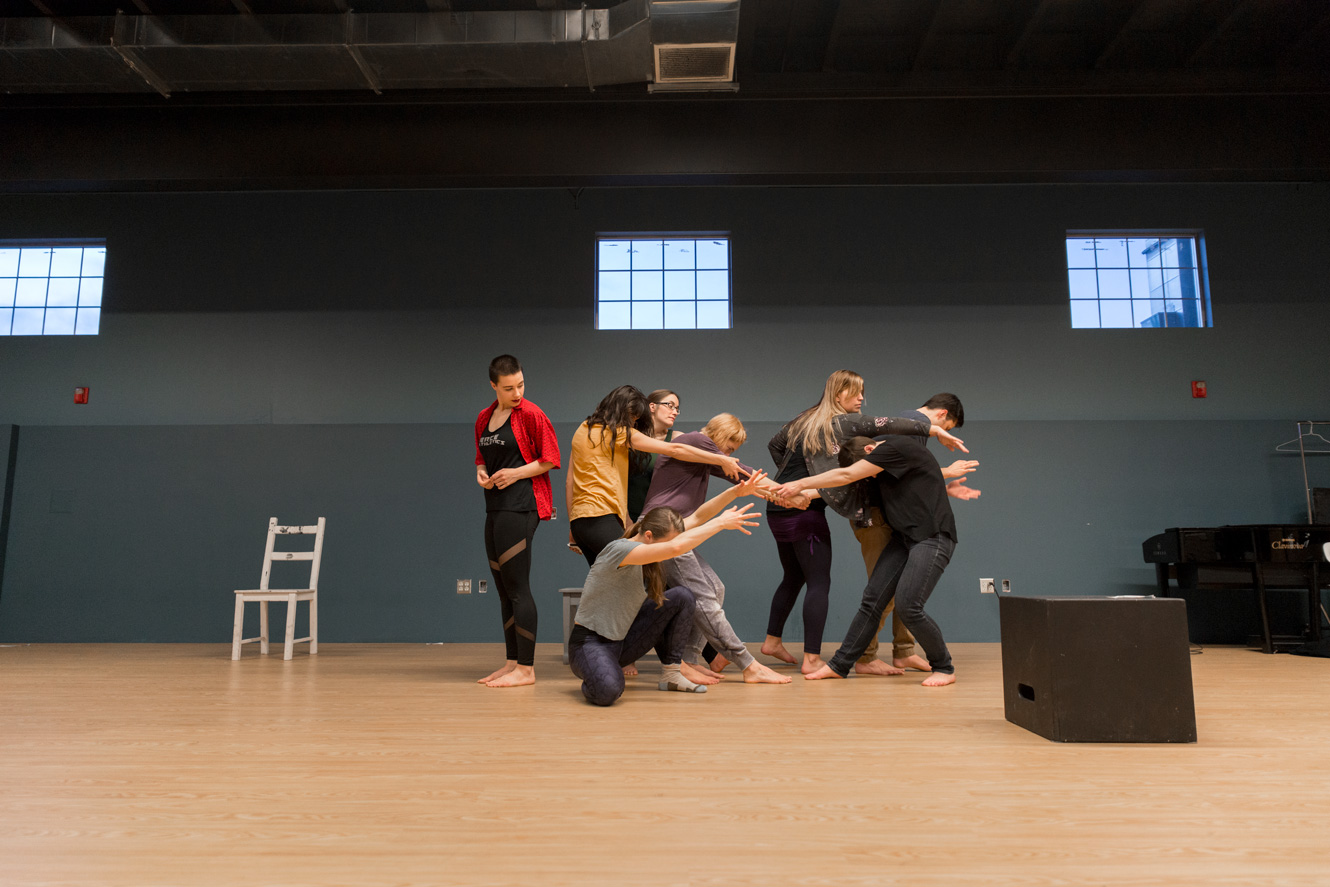
People wanted to know, “Do I have to participate?” Because they do not want to participate, I’m guessing.
TS: Yes. And how you relate to the audience can define the kind of performance you’re [going to have.] So that was interesting to investigate first: “How do we care for the audience?” Early on in S5, I was keenly aware, based on ticket sales and emails, that people were anxious about trying something new. We are creatures of habit, and that’s fine, I’m not knocking that. So, [as an answer to that anxiety] we had guides and docents always taking care of [the audience.] We had some catch phrases, if you will, throughout, that were pre-recorded: my voice narrating, “Look around, don’t worry. We’ll take care of you. We got you. This is for you.” I must have said that ten times during the course of that piece.
You have a super soothing voice, by the way. [laughter]
The thing I want to celebrate about us is, from the moment you buy your ticket, we’re thinking about you and your experience.
What happened after the coordinates and the map? I’m having trouble imagining.
Essentially, you had a set of headphones to listen to the stories unfolding as you walked [outdoors,] following a guide. The guide’s job was to make sure you could experience the art safely, crossing the street all together at one time, or pausing when you’re supposed to and [focus on] the one thing you’re supposed to look at. Pointing out the couple at the top of the parking garage.
So, I’m on the sidewalk, looking across the street towards a rooftop? This is an angle I’ve never seen from my cushy theater seat.
Exactly. Sometimes you saw it from four flights up and sometimes you saw the performance from across a football field.
Was that hard to pull off? The timing and—
Logistics? Yes. [Laughter] It was very hard.
But it was worth it, I bet.
Yes. After that first five minutes, people responded very well. You just have to be brave enough to walk through the door. And we’ve got you.
I’ve got to be brave?
It takes a little bit of bravery.
I can do that. And you’re going to take care of me?
Absolutely.
Downtown
April 18, 2018
Creators, Makers, & Doers highlights the lives and work of Boise artists and creative individuals. Selected profiles focus on individuals whose work has been supported by the Boise City Dept. of Arts & History.

